|
TECnology Hall of Fame 2007
Induction Ceremony: October
5, 2007
AES Convention, Javits Center, New York City
The TEC Foundation for Excellence
in Audio established the TECnology Hall of Fame
in 2004 to honor and recognize audio products
and innovations that have made a significant
contribution to the advancement of audio technology.
Inductees to the TECnology Hall of Fame are
chosen by a panel of more than 50 recognized
audio experts, including authors, educators,
engineers, facility owners and other professionals.
Products or innovations must be at least 10
years old to be considered for induction.
1919 Leon Theremin—The
Theremin
1925 Chester Rice & Edward Kellogg, General
Electric Co.—Modern Dynamic
Loudspeaker
1940 Dr. Walter Weber—AC
Tape Bias
1956 Neumann—Neumann
Stereo Disk Lathe
1957 Stefan Kudelski—Nagra
III Tape Recorder
1958 Cannon—XLR Connector
1959 Rein Narma—Fairchild
670 Compressor Limiter
1967 Crown International—DC
300 Power Amplifier
1970 Rupert Neve—Neve 1073
Console Module
1971 AKG—C-414 Condenser
Microphone
1972 MCI—JH-400 Series Inline
Console
1975 Eventide—H910 Harmonizer
1976 EMT—250 Digital Reverb
1978 3M—Digital Audio Mastering
System
1981 Sony—PCM-F1 Digital
Recording Processor
AUDIO
INNOVATIONS THAT CHANGED PRO AUDIO
By George Petersen
Edison's first cylinder recorder
was born 130 years ago, and while other technologies—from
automobiles to aerospace—emerged in that
era, audio is what counts for us true devotees.
Unfortunately, the history of pro audio is woefully
neglected, with sources scarce, if not impossible
to find.
An offshoot of the TEC Awards,
the TECnology Hall of Fame began in 2004 to spotlight
significant innovations in pro audio history.
Selecting a few inductees
from a more than a hundred years of heritage is
not easy. A committee of more than 50 industry
leaders, engineers, producers, educators and journalists
volunteered to help pick audio innovations—the
only “rule” being that any selection
must be at least 10 years old. Bear in mind that
the TECnology Hall of Fame is a continuing project
and more honorees will be added in the future.
Listed chronologically, here are the 15 entries
for 2007:
LEON
THEREMIN
THEREMIN (1919)
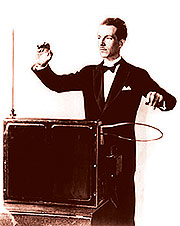 Who
would believe an innovative electronic musical
instrument developed in 1919 could maintain its
massive cult status and popularity after nearly
90 years? However, the Theremin is no ordinary
instrument. Who
would believe an innovative electronic musical
instrument developed in 1919 could maintain its
massive cult status and popularity after nearly
90 years? However, the Theremin is no ordinary
instrument.
Created by Russian physicist
Lev Sergeivich Termen (also known as Leon Theremin),
the Theremin is described in its U.S. patent (#
1,661,058) as a “novel method of and means
for producing sounds in musical tones or notes
in variable pitch, volume and timbre.” The
key word here is “novel,” as the system
consists of two oscillator circuits where amplitude
and frequency are controlled by the proximity
of the user’s hands to the Theremin’s
two antennas, with no need to actually touch the
instrument.
Over the years, there have
been numerous serious Thereminists, yet the instrument
is best known for creating outerworldly effects
and music for horror and science fiction films
ranging from the classic The Day the Earth
Stood Still to countless budget releases.
A common myth is that a Theremin was used on the
Beach Boys’ “Good Vibrations."
The instrument was actually a Tannerin (Electro-Theremin)
played by trombonist Paul Tanner, which uses a
similar technology, but substitutes a hardware
slide controller for the antenna.
One well-known Theremin fan
was the late synthesis pioneer Bob Moog, who built
the units for decades and sold completed systems
and kits through Moog Music (www.moogmusic.com).
Moog also published a DIY Theremin project in
the Feb., 1996 issue of Electronic
Musician magazine.
CHESTER RICE & EDWARD
KELLOGG, GENERAL ELECTRIC CO.
MODERN DYNAMIC LOUDSPEAKER (1925)
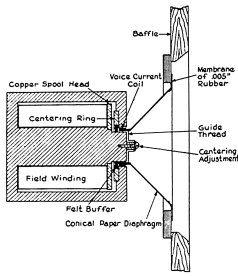 Timing
is everything and the development of the modern
dynamic loudspeaker by two General Electric engineers—Chester
W. Rice and Edward W. Kellogg—was right
on time. In a landmark article, “Notes on
the Development of a New Type of Hornless Loudspeakers,”
published in the Sept. 1925 edition of AIEE Transactions,
these two General Electric engineers describe
what we know consider the roots of modern loudspeaker
technology. Timing
is everything and the development of the modern
dynamic loudspeaker by two General Electric engineers—Chester
W. Rice and Edward W. Kellogg—was right
on time. In a landmark article, “Notes on
the Development of a New Type of Hornless Loudspeakers,”
published in the Sept. 1925 edition of AIEE Transactions,
these two General Electric engineers describe
what we know consider the roots of modern loudspeaker
technology.
After testing numerous materials
and approaches, Rice and Kellogg suggest a lightweight
(paper) conical diaphragm attached to a coil of
wire that’s energized by a large magnet
structure. In this proposal, the latter was an
electromagnet, as an affordable alternative to
the great expense of large permanent magnets in
those days. Beyond simply describing a new type
of transducer, the pair lay out many of the basic
tenets of loudspeaker design, such as detailing
the importance of the baffle in preventing the
“circulation” of the sound from the
speaker’s forward and backward motion. Rice
and Kellogg also discuss the need for more powerful
amplifiers to provide adequate headroom required
for quality reproduction, noting that before the
“full benefit of a high grade loud speaker
may be realized, it is important that the amplifier
which goes with it should have sufficient capacity
to give a natural volume or intensity."
The Rice/Kellogg electro-dynamic
speaker design was licensed to RCA, which incorporated
it into its successful Radiola line.
WALTER
WEBER
AC TAPE BIAS (1940)
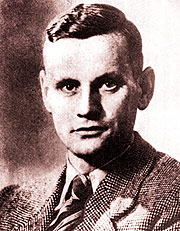 Born
100 years ago, Dr. Walter Weber was a Siemens
engineer who was recruited by Dr. Hans Joachim
Von Braunmühl to work for Reichs-Rundfunk-Gesellschaft
(German Broadcasting) in 1932. While at RRG, von
Braunmühl assigned Weber to look into means
of improving the performance of AEG Magnetophon
tape recorders. Born
100 years ago, Dr. Walter Weber was a Siemens
engineer who was recruited by Dr. Hans Joachim
Von Braunmühl to work for Reichs-Rundfunk-Gesellschaft
(German Broadcasting) in 1932. While at RRG, von
Braunmühl assigned Weber to look into means
of improving the performance of AEG Magnetophon
tape recorders.
However, with the introduction
of BASF’s ferric-oxide tape in 1939, the
Magnetophon was approaching broadcast standards
and one of Weber’s interests was the application
of bias currents. Earlier research (such as by
Americans Wendell Carlson and Glenn Carpenter
in 1921) had shown that adding a high frequency
AC bias signal could raise the quality of magnetic
recording, but given the poor performance of wire
recorders, the improvement was minimal.
During experiments with a
DC biasing scheme in the spring of 1940, Weber
inadvertently applied a AC current to the recording
chain, leading to his rediscovery of the benefits
of AC biasing. The effect was dramatic, offering
a 10dB improvement in the Magnetophon’s
noise floor.
Weber filed a patent (German
#743,411) on July 28, 1940, and the AC biasing
technology was licensed to AEG, who incorporated
it into its Model K4 HF-Magnetophons that launched
a year later. And with a frequency response of
a then-astonishing 10kHz, tape recording was on
its way to eventually become the world production
standard.
Interestingly, one of Weber
and von Braunmühl's design projects had nothing
to do with tape. In 1935, they filed a patent
for the Braunmühl-Weber dual diaphragm capsule,
the first unidirectional condenser mic, which
eventually became the Neumann M7 capsule used
in the U47. In July of 1944, at age 37, Walter
Weber suffered a fatal heart attack, but his legacy
lives on.
NEUMANN
NEUMANN STEREO DISK LATHE (1956)
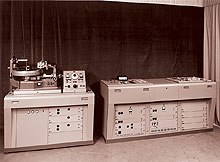 In
1953, Neumann engineers began developing the AM
32, a disk lathe with the ability of varying the
groove pitch, controlled by the amplitude of the
input signal, rather than a constant pitch. By
mounting a preview head on the source tape deck,
its signal could be fed to the lathe’s drive,
which made a small adjustment in the groove spacing
approximately one-half rotation before the cutterhead
received that same signal from the playback head. In
1953, Neumann engineers began developing the AM
32, a disk lathe with the ability of varying the
groove pitch, controlled by the amplitude of the
input signal, rather than a constant pitch. By
mounting a preview head on the source tape deck,
its signal could be fed to the lathe’s drive,
which made a small adjustment in the groove spacing
approximately one-half rotation before the cutterhead
received that same signal from the playback head.
Co-developed with Teldec (a
joint venture of English Decca and German Telefunken),
the Neumann ZS 90/45 stereo cutterhead arrived
in 1956 and combined vertical and lateral recording
in a V-shaped groove, each slope set at an angle
of 45 degrees. The ZS 90/45 was driven by the
VG1 (Verstärkergestell Eins) cutting electronics
with two 60-watt tube amps.
Besides controlling groove pitch, the system’s
SA 32 carriage could also use the difference between
the left and right signals to modulate the depth
of the cut and also adjusted the groove pitch
based on the depth of the cut, as deeper cuts
require wider grooves. This first electrodynamic
feedback stereo cutterhead system set the stage
for the world-standard SX 45, SX 68, SX 74 and
SX 84 cutterheads that followed.
STEFAN
KUDELSKI
NAGRA III TAPE RECORDER (1957)
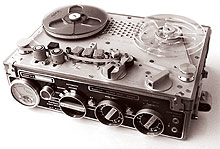 Born
in 1929 in Warsaw, Stefan Kudelski was only 10
when his family fled Poland, to Hungary and France,
and finally settling in Switzerland in 1943. After
completing his college studies, he founded the
Kudelski company in 1951 and began creating the
Nagra (the name means "will record"
in Polish) portable recorder. Designed for high-quality
portable recording, the initial Nagra I and II
models were driven by a wind-up clockspring mechanism. Born
in 1929 in Warsaw, Stefan Kudelski was only 10
when his family fled Poland, to Hungary and France,
and finally settling in Switzerland in 1943. After
completing his college studies, he founded the
Kudelski company in 1951 and began creating the
Nagra (the name means "will record"
in Polish) portable recorder. Designed for high-quality
portable recording, the initial Nagra I and II
models were driven by a wind-up clockspring mechanism.
The breakthrough came
in 1957 with the Nagra III, a compact, 11-pound
mono 3.75/7.5/15 ips reel-to-reel deck. With 12
D cell batteries powering its DC servo-controlled
motor and Germanium transistor electronics, the
Nagra III's performance could rival much larger
studio machines. The deck's rugged aluminum chassis
and "Modulometer" peak-reading level
meter appealed to pros who needed a dependable,
near-indestructible location recorder.
With updates, such the addition
of Neopilot sync in 1963, the Nagra III soon became
the standard for location film recording and received
an Award of Merit from the Academy of Motion Picture
Arts and Sciences in 1965. After an 11-year span,
the Nagra III was eventually replaced with the
Nagra IV in 1968 and the Models 4.2 and stereo
IV-S in 1971.
CANNON
XLR CONNECTOR (1958)
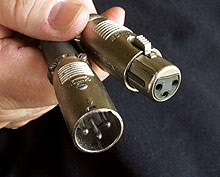 Originally,
the XLR was intended for aircraft and instrumentation
applications—rather than audio—but
we’re glad it’s here. In use for balanced
pro audio for nearly 50 years, the three-pin versions
of Cannon’s XLR connector are so ubiquitous
in both analog and digital (AES/EBU) connections
that most people in our industry don’t even
remember those pre-XLR days. Once upon a time,
audio gear was fitted with whatever the manufacturer
deemed appropriate, with DIN and Tuchel connections
common in Europe and various Amphenol types in
the states. Originally,
the XLR was intended for aircraft and instrumentation
applications—rather than audio—but
we’re glad it’s here. In use for balanced
pro audio for nearly 50 years, the three-pin versions
of Cannon’s XLR connector are so ubiquitous
in both analog and digital (AES/EBU) connections
that most people in our industry don’t even
remember those pre-XLR days. Once upon a time,
audio gear was fitted with whatever the manufacturer
deemed appropriate, with DIN and Tuchel connections
common in Europe and various Amphenol types in
the states.
The move to Cannon’s
XLR design wasn’t exactly an overnight success,
taking at least 15 years, but it provided a universal
solution, where a mic cable could double as a
line cable and two cables could be connected to
make a single, longer cord. The XLR name stems
from being Cannon’s "X" Series,
with a latching/locking "L" feature
and having an elastomeric/rubber "R"
insulator.
Besides the common three-pin
XLR-3M (male) and XLR-3F (female ) connectors
in audio jacks and inline plugs, other XLR types
common to audio include 4-pin types for intercom
and 12-volt power connections, 5-pin stereo mics
and various multipin configurations for tube mics/surround
mics/etc. Today, XLR-style connectors are available
from many sources, including the original—now
ITT Cannon.
REIN
NARMA
FAIRCHILD 670 COMPRESSOR LIMITER (1959)
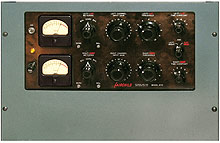 The
Fairchild 670 is often referred to as the "holy
grail" of outboard devices for its rarity,
value (currently about $30,000 on the used market)
and usefulness in a wide variety of studio situations.
And this hand-wired stereo unit is a beast, with
20 vacuum tubes (21 if you include the 5V4 rectifier)
and 14 transformers tucked within its 65-pound
chassis. The
Fairchild 670 is often referred to as the "holy
grail" of outboard devices for its rarity,
value (currently about $30,000 on the used market)
and usefulness in a wide variety of studio situations.
And this hand-wired stereo unit is a beast, with
20 vacuum tubes (21 if you include the 5V4 rectifier)
and 14 transformers tucked within its 65-pound
chassis.
The origins of the 670 (and
mono 660 version) are fairly humble, coming from
Estonian-born Rein Narma. In the post-war years,
this refugee from Soviet Russia worked for the
U.S. Army as a broadcast/recording tech during
the Nuremberg trials, later immigrated to the
New York and took a job at Gotham Recording. Narma
and several others founded Gotham Audio Developments,
to build recording gear. Les Paul hired him to
modify his first 8-track and later Narma built
consoles for Rudy Van Gelder, Olmsted Recording
and Les Paul, who also asked him to build a limiter.
After beginning the project, Sherman Fairchild
heard about it, licensed the design and hired
Narma as the company's chief engineer.
CROWN
INTERNATIONAL
DC 300 POWER AMPLIFIER (1967)
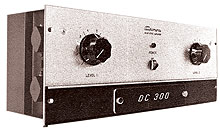 In
many ways, the 1967 introduction of the AB+B-class
DC 300 ushered in the era of the modern, high
power amplifier. Offering 340 watts/channel (at
4 ohms), this 4-rackspace, 40-pound beast came
in at less than the "magic" $1/watt
price point, based on its original $685 retail.
And with its rock-solid construction, and internal
thermal and V-I protection modes, the DC 300 was
the ideal solution for high-end consumers, high-SPL
studio monitors and live sound systems coming
into vogue with the summer of love. In
many ways, the 1967 introduction of the AB+B-class
DC 300 ushered in the era of the modern, high
power amplifier. Offering 340 watts/channel (at
4 ohms), this 4-rackspace, 40-pound beast came
in at less than the "magic" $1/watt
price point, based on its original $685 retail.
And with its rock-solid construction, and internal
thermal and V-I protection modes, the DC 300 was
the ideal solution for high-end consumers, high-SPL
studio monitors and live sound systems coming
into vogue with the summer of love.
Yet through it all, someone
at Crown has always maintained a sense of humor.
The original service manual for the DC 300 is
entitled "300 Watts and a Cloud of Smoke"
and its introduction includes advice such as "try
to avoid going to sleep while reading the rest
of this manual."
Years later, a DC 300 was
immortalized in a magazine ad that showed the
unit half-submerged in a muddy field, based on
a real story:
"In the early
evening of September 17, 1973, Jay Barth was at
the wheel of a 22-foot utility truck that was
loaded with sound equipment. Just north of Benton
Harbor, Mich., an oncoming car crossed the center
line; fortunately, Jay steered clear of the impending
collision. Unfortunately, a soft shoulder caused
the truck to roll two and one half times. Exit
several DC 300As through the metal roof of the
truck's cargo area. The airborne DC 300As finally
came to rest—scattered about in a muddy
field, where they remained partially submerged
for four and a half hours. Jay miraculously, escaped
injury; the amplifiers apparently had not. Unbelievably,
after a short time under a blow dryer, all the
amps worked perfectly and are still going strong.
The rest—and the truck—is history."
Even today, some 40 years
after their original introduction, many DC 300s
are still used in professional audio applications,
a testament to Crown reliability.
RUPERT
NEVE
NEVE 1073 CONSOLE MODULE (1970)
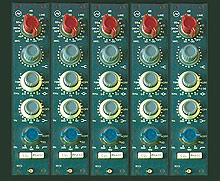 In
1970, Rupert Neve designed the first 1073 mic
preamp module for a new A88 console for Wessex
Studios. It became a legend, still widely regarded
as one of pro audio's best preamplifiers. The
Class-A design 1073 mic/line preamp has three
EQ bands (a fixed 12kHz HF band and switchable-frequency
LF/MF cut/boost bands) and a passive -18dB/octave
high pass filter with 50/80/120/160 Hz steps.
EQ bypass and "phase" (polarity) switches
are also standard. In
1970, Rupert Neve designed the first 1073 mic
preamp module for a new A88 console for Wessex
Studios. It became a legend, still widely regarded
as one of pro audio's best preamplifiers. The
Class-A design 1073 mic/line preamp has three
EQ bands (a fixed 12kHz HF band and switchable-frequency
LF/MF cut/boost bands) and a passive -18dB/octave
high pass filter with 50/80/120/160 Hz steps.
EQ bypass and "phase" (polarity) switches
are also standard.
Designed as 80-series console
modules and not originally intended for standalone
use, Neve's 1073s and 1084s were often removed
from older consoles and put into third-party racks
and housings. The circuit has been widely imitated
and cloned (in both hardware and software) and
the Neve company now offers recreations of the
1073 in rack and module form.
But according to Rupert Neve,
the secret to the original 1073's success was
transformers: "I've thought about this a
lot," Neve recalls, "and it had to be
in the input and output transformers and that
way in which the response rolls off. If you take
a very large rise time signal and throw it at
a stage that's not man enough to take it, you
get slew rate problems. There are few things that
sound more elusive or worse than slew rate problems—it
just doesn't sound right, with a soggy sound.
What we did with the transformers was to build
them out like filters to the maximum that we could
squeeze out in terms of high frequency response
and then make sure they rolled off smoothly—with
no peaking or things of that sort."
 AKG AKG
C 414 CONDENSER MICROPHONE (1971)
The availability of reliable,
quality Field Effect Transistors in the 1960s
opened the door for replacing tube mics with compact,
solid state models. In 1970, AKG's Karl Peschel
took the CK 12 capsule from the C 12A Nuvistor
tube mic and paired it with FET electronics, resulting
in the C 412. A year later, adding a second bass
rolloff position and a fourth polar pattern created
the C 414 comb.
From 1974 onwards, engineer
Norbert Sobol supervised the C 414 design, adding
numerous improvements in audio performance and
features along the way. These included the C 414
EB (1976), C 414 EB-P 48 (1980), models C 414
B-ULS and –TL (1986), C 414 B-TL II (1993)
and the current C 414 B-XLS and –XL II.
With well over 100,000 sold,
the C 414 remains a popular choice whether in
earlier versions or the latest models—now
updated with LED displays and a fifth (wide cardioid)
pattern.
MCI
JH-400 SERIES INLINE CONSOLE (1972)
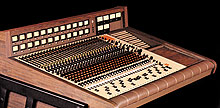 MCI
Electronics founder Grover C. “Jeep”
Harned was a pro audio innovator, from the first
24-track recorder—a modified Ampex 300 in
1968—to the tape Auto Locator (1972) and
commercializing the inline console. Credit for
the first inline-style console designs actually
goes to Dan Flickinger, who designed a number
of custom mixers that put tape monitoring within
the channel modules, but had track assignments
in a separate section. However, the popularity
of the modern inline console stems from Nashville
audio dealer Dave Harrison (later founder of Harrison
Consoles), who approached Harned with this new
approach to console design. MCI
Electronics founder Grover C. “Jeep”
Harned was a pro audio innovator, from the first
24-track recorder—a modified Ampex 300 in
1968—to the tape Auto Locator (1972) and
commercializing the inline console. Credit for
the first inline-style console designs actually
goes to Dan Flickinger, who designed a number
of custom mixers that put tape monitoring within
the channel modules, but had track assignments
in a separate section. However, the popularity
of the modern inline console stems from Nashville
audio dealer Dave Harrison (later founder of Harrison
Consoles), who approached Harned with this new
approach to console design.
Harned and MCI engineer Lutz
Meyer helped Harrison refine the JH-400. In a
day when most studio consoles were custom, the
JH-400s were revolutionary: They were standardized
"production" models with a choice of
user options and incorporated Harris 911 IC op-amps,
thus lowering costs and simplifying manufacturing.
The first JH-416 models offered 24 inputs/outputs
with quad panning/monitoring, 3-band EQ and P&G
faders. Options included a 32-input version, VCA
grouping and automation and switchable peak/VU
meters. The JH-400 (the "JH stood for Jeep
Harned) offered an affordable pro console to the
burgeoning studio industry and five years later,
a 1977 Billboard poll gave MCI the leading
share (14.3 percent) among studios. That same
year, MCI unveiled the updated JH-500 series,
which offered a four-band EQ, more sends/returns
and plasma VU displays.
Harned sold MCI to Sony in
1982 and retired. He will long be remembered as
a pioneer who made significant advancements to
the state of pro audio.
EVENTIDE
H910 HARMONIZER (1975)
 When
you name a product after a Beatles tune (the model
number refers to the “One After 909”),
it better be good. However, when Eventide founder
Richard Factor assigned his young designer Anthony
Agnello (the company’s first “degreed”
engineer) to begin building a harmony processor
in 1974, they had no idea that they’d be
creating an audio classic of their own. The version
they demoed at the AES show later that year didn’t
resemble the final product at all, with a music
keyboard controller supported by a hand-wired
box, but the reaction was universally positive,
both among showgoers and Yes vocalist Jon Anderson,
who tested the first prototype. Soon after (and
with the keys controller offered as an option),
the Harmonizer H910 was born. When
you name a product after a Beatles tune (the model
number refers to the “One After 909”),
it better be good. However, when Eventide founder
Richard Factor assigned his young designer Anthony
Agnello (the company’s first “degreed”
engineer) to begin building a harmony processor
in 1974, they had no idea that they’d be
creating an audio classic of their own. The version
they demoed at the AES show later that year didn’t
resemble the final product at all, with a music
keyboard controller supported by a hand-wired
box, but the reaction was universally positive,
both among showgoers and Yes vocalist Jon Anderson,
who tested the first prototype. Soon after (and
with the keys controller offered as an option),
the Harmonizer H910 was born.
“With memory
for audio was just becoming possible, the H910
was the right box at the right time,” says
Agnello. Offering pitch shifting (±1 octave),
delay (up to 112.5 ms), feedback regeneration
and more from an easy-to-use $1,600 box, the H910
was a hit—an instant studio fave and still
a legacy tool years later. Users soon found all
sorts of applications, ranging from regenerative
arpeggios to bizarre sound design effects to lush
guitar or vocal fattening. The first customer—New
York City’s Channel 5—immediately
put an H910 to work, downward pitch shifting “I
Love Lucy” reruns that were sped up to squeeze
in more commercials. “The Harmonizer could
be used for good or evil,” warns Agnello,
“and the speeded-up sound of Lucy’s
occasional shrill shrieks was definitely evil.
Taming that was a good thing.”
Artists loved the Harmonizer’s
versatility. Frank Zappa put one in his guitar
rack. Producer Tony Visconti used it for the memorable
snare sounds on David Bowie’s Young Americans;
ditto for engineer Tony Platt on AC/DC's Back
in Black. Eddie Van Halen had a pair (set
to either 18-cents sharp and 18-cents flat with
a 12ms delay on one side or +12c/-15c/18ms) as
part of his trademark guitar sound. Tom Lord-Alge’s
setup for Steve Winwood’s soulful vocals
on “Back in the High Life” also employed
two slightly detuned H910s (one sharp/one flat)
with an 18ms spread. The twin Harmonizer effect
was so popular that Eventide recreated it as the
“Dual 910” program in the H3000 UltraHarmonizer
that followed it a dozen years later.
EMT
MODEL 250 DIGITAL REVERB (1976)
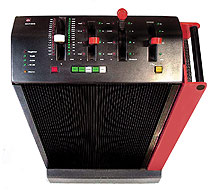 Considered
one of the pioneers of digital audio, Barry Blesser
helped launch Lexicon in 1971 and developed the
EMT 250, the first commercial digital reverb,
in 1976. EMT (Elektromesstechnik) was no stranger
to reverb, having created the classic Model 140
plate system back in 1957 and the gold foil Model
240 in 1970. As Blesser had designed a number
of EMT analog products in the early 1970s, the
collaboration of EMT and Massachusetts-based Dynatron
made sense. Considered
one of the pioneers of digital audio, Barry Blesser
helped launch Lexicon in 1971 and developed the
EMT 250, the first commercial digital reverb,
in 1976. EMT (Elektromesstechnik) was no stranger
to reverb, having created the classic Model 140
plate system back in 1957 and the gold foil Model
240 in 1970. As Blesser had designed a number
of EMT analog products in the early 1970s, the
collaboration of EMT and Massachusetts-based Dynatron
made sense.
Barry Blesser and Karl-Otto
Bäder designed the algorithms (U.S. patent
#4,181,820); Dynatron's Ralph Zaorski designed
the digital hardware; and EMT built the converters,
I/Os, power supply and the unique user interface,
with its large upright chassis and rocket ship-style
control levers for decay and delay. Its 400 ICs
and 16K of memory of this one-in/four out unit
required three fans and heat sinks covering the
entire cabinet exterior. "We put the power
supply on the outside and painted it red,"
Blesser recalls. "We took all the problems
and turned them into unique signature symbols."
The EMT 250 carried a $20,000
price on its debut and some 250 units were produced,
many of which are still in use today and valued
for their effects and reverb sounds. A later model,
the EMT 251, added an LCD readout, improved HF
response and more flexibility, but the algorithm
was not the same as the classic EMT 250.
© Peter Bermes (Bermes Design)
3M
DIGITAL AUDIO MASTERING SYSTEM (1978)
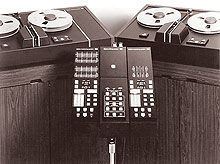 Best
known for its lines of tape media and professional
analog recorders, with its M series of multitrack
and 2-track machines, the Mincom division of 3M
spent several years developing a digital recording
system, including two years of joint research
with the BBC. The result was the 3M Digital Audio
Mastering System, which consisted of a 32-track
deck (16-bit, 50 kHz audio) running 1-inch tape
and a 4-track, 1/2-inch mastering recorder. Best
known for its lines of tape media and professional
analog recorders, with its M series of multitrack
and 2-track machines, the Mincom division of 3M
spent several years developing a digital recording
system, including two years of joint research
with the BBC. The result was the 3M Digital Audio
Mastering System, which consisted of a 32-track
deck (16-bit, 50 kHz audio) running 1-inch tape
and a 4-track, 1/2-inch mastering recorder.
Both decks operated at 45
ips, offering a 30-minute record time from a 7,200-foot,
12.5-inch reel or 45-minutes from a 14-inch, 9,600-foot
spool. Perhaps the most curious aspect of the
3M system was its conversion scheme. As no true
16-bit converters were available, it combined
separate 12-bit and 8-bit converters to create
16-bit performance.
Although the 3M system was
a year away from actual deliveries, engineer Tom
Jung (now of DMP Records) agreed to beta-test
the prototypes at Sound 80 in Minneapolis, using
them as a backup system during sessions being
cut direct-to-disk—lacquer disk, not hard
disk! The digital session tapes were judged superior
to the disk masters, and in December 1978, the
first commercial albums cut on the system were
released: Flim & The BB's, by jazz group Flim
& The BB's, and Aaron Copeland's Appalachian
Spring, by the St. Paul Chamber Orchestra. The
latter was nominated for three Grammy Awards,
winning for Best Chamber Music Performance.
Priced at $150,000 ($115,000
for the 32-track and $35,000 for the 4-track),
the first two-machine systems were installed in
early 1979 at Sound 80 and in Los Angeles at A&M
Studios, the Record Plant and Warner Bros.' Amigo
Studios. Among the notable early pop releases
cut on the 3M system included Ry Cooder’s
Bop Till You Drop (engineered by Lee Herschberg)
and Donald Fagen’s The Nightfly, engineered
by Roger Nichols.
SONY
PCM-F1 DIGITAL RECORDING PROCESSOR (1981)
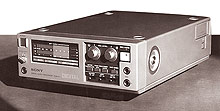 Once
in a while, an audio product arrives that’s
a failure in the consumer realm (such as the DAT
format or Yamaha’s NS-10 speakers) but is
a hit with pro recordists. Sony’s PCM-F1
is one such example. Originally designed as a
means for consumers to make digital recordings
of CDs, FM broadcasts or home performances, the
PCM-F1 debuted in 1981. Once
in a while, an audio product arrives that’s
a failure in the consumer realm (such as the DAT
format or Yamaha’s NS-10 speakers) but is
a hit with pro recordists. Sony’s PCM-F1
is one such example. Originally designed as a
means for consumers to make digital recordings
of CDs, FM broadcasts or home performances, the
PCM-F1 debuted in 1981.
Essentially, the system combined
a recording processor that used the EIAJ’s
(Electronic Industries Association of Japan) 14-bit
PCM specification for digitizing audio and storing
it as a video signal—essentially a moving
monochrome barcode. The concept of a two-piece
system (connecting a PCM processor to any VCR—Beta,
VHS or U-matic—for recording) was unpopular
with consumers, but at $1,900, Sony's PCM-F1 was
a hit with studios. The Technics SV-P100 ($3,000)
went one step further: It was a 14-bit EIAJ processor
combined with a VHS transport. Years before DAT,
it was the first digital audio cassette recorder,
and Mobile Fidelity even released a few projects—such
as Pink Floyd's Dark Side of the Moon—on
stereo PCM VHS tapes.
PCM processors from Aiwa,
Akai, Sansui, JVC and Technics rigidly stuck to
the 14-bit EIAJ standard; only Sony's PCM-F1 as
well as the later PCM-701/501/601 units and the
Nakamichi DMP-100—a black-finish F1 with
improved analog components—offered a choice
of (switchable) 14/16-bit performance. Apogee
Electronics once sold upgrades for replacing a
PCM-F1’s anti-aliasing filters with high-performance
Apogee versions.
Recording on EIAJ digital
processors had its ups and downs. Being video-based,
the system recorded at 44.056 kHz rather than
44.1kHz and digital editing was difficult—at
best—and only frame-accurate, requiring
a high-end assembly editing rig with multiple
synchronized decks. On the plus side, the processors
had no moving parts, so a worn-out transport simply
meant finding another VCR; and tape clones/backups
could easily be made using two VCRs. And as the
PCM-F1 had separate encode and decode circuitry,
four-track, sound-on-sound recordings were possible
using one processor and two VCRs (one designated
as play/the other as record). Alternatively, one
could make simultaneous 4-track recordings by
combining the PCM digital tracks with a video
deck’s “Hi-Fi” tracks. This
was great for live recordings where a board mix
or close-in mics went digital and room ambience
or mix position mics routed to the Hi-Fi tracks.
Paired with the optional
SL-F1 Betamax deck, the PCM-F1 was the first portable,
battery-operated digital recording system. A few
brave souls—myself included—even went
so far as to make multitrack recordings using
two (or more) synchronized PCM-F1s. But one thing
was certain: whether stereo or 4-track, the democratization
of digital had arrived.
Mix executive editor George
Petersen also runs a small record label (www.jenpet.com),
and still owns several Sony PCM-F1s, but hasn't
used them recently.
For more information, click
here.
|

